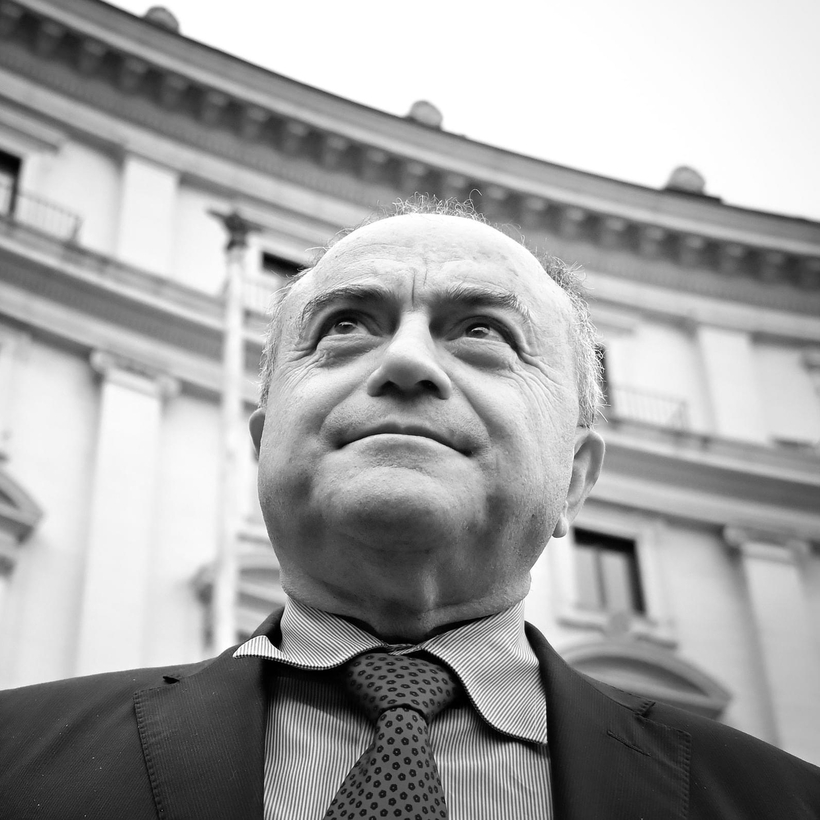Last week, a car bomb exploded on the outskirts of Rome. A white car blew up alongside the gray car next to it. Both belonged to Sigfrido Ranucci, the journalist behind Report, Italy’s leading investigative television program. (Ranucci was not in the vehicle at the time of the bombing.) Though no conclusive evidence has been found regarding the perpetrator, the last attempt on his life, in August 2021, was attributed to the ’Ndrangheta, the criminal network based in Calabria.
The rise of the Calabrian ’Ndrangheta to global prominence stands in sharp contrast to the Sicilian Mafia’s decline.The feared Cosa Nostra has dwindled into a local force since Francis Ford Coppola filmed The Godfather—its international reach now the stuff of the Corleones and penne alla vodka. Amid the assassination of Italian judges Giovanni Falcone and Paolo Borsellino by car bombings, in 1992, an anti-Mafia war began, and the Cosa Nostra’s power waned. Now its 3,000 or so operators work mostly locally, extorting farmers and businessmen in the South.

The ’Ndrangheta, an organization based in Calabria, the toe of Italy’s boot, has risen from the ashes in its place. The ’Ndrangheta—a term deriving from the ancient Greek word andragathía, meaning “gallantry” or “manly virtue”—far exceeds the Cosa Nostra in influence, even at its height. The Italian Chamber of Deputies has called it “the most powerful and dangerous Mafia organization in the world,” estimating its annual turnover at $60 billion. By comparison, Mexico’s Sinaloa cartel is estimated to bring in roughly $10 billion a year. The ’Ndrangheta controls 80 percent of Europe’s cocaine trade and is the only Mafia with a presence on five continents, operating in 84 countries.
And if that Mafia—and all of Italy’s Mafias, for that matter—had a public enemy No. 1, it would be the prosecutor Nicola Gratteri, who has been referred to as “Italy’s most wanted man.” A short, bald 67-year-old with dark, deep-set eyes, he never talks about himself. If he makes a television appearance, he aims only to educate audiences on organized crime. He economizes words. You will never hear an “um” or a “but” from him.
He has been fighting Italy’s Mafia organizations since the early 1980s, when, at 28, he became one of the country’s youngest prosecutors. In 1989, an assassination attempt targeted his fiancée, Patrizia, at her house in Locri, near Calabria’s regional capital, Reggio Calabria. Bullets riddled her house, and then came an ominous phone call: “Why are you marrying a dead man?” The line clicked off. She married Gratteri anyway. Since then, he has lived under permanent police protection. Armed officers escort him from the courthouse to his home. He hasn’t been to a cinema or a restaurant in almost 30 years. “I never went to school to see how my children were doing,” he told the BBC in 2023. “I have never seen a Christmas play.”
In 1993, following the murders of Falcone and Borsellino, Gratteri escaped three assassination attempts in three weeks. In 2005, in the plains of Gioia Tauro, the ’Ndrangheta’s heartland, police discovered an arsenal of weapons—Kalashnikov assault rifles, submachine guns, pump-action shotguns—that had been stowed away to attack him. Now he and his wife live separately and meet only at a safe house a few times a month. His adult sons live in Northern Italy, and Gratteri sees them for 30 minutes every two months.

“If I let death condition me, I wouldn’t do my job well,” he says to me. “I think about it—when I’m afraid, my tongue tastes bitter. Yet I’ve never allowed fear of consequences to influence my choices.” He adds: “I often talk to death. I wrestle with it.”
In Gerace, on Calabria’s eastern coast, where Gratteri grew up in the 1960s and 1970s, ’Ndrangheta violence was a fact of daily life. “When I went to school I saw dead people in the streets,” he told the BBC. A gang member eventually killed his best friend’s father the year his friend turned 11; later, his friend was gunned down trying to get revenge.
When pressed on what keeps him going after decades of threats and isolation, he says: “I put a lot of passion into [my job] because I believe it’s worthwhile.”
In 2021, he organized the largest anti-Mafia trial in Italy since the 1990s, where, to accommodate the 400 lawyers and 900 witnesses, a call center on the outskirts of Lamezia Terme was transformed into a vast courtroom complex with wide corridors and black desks. Just over 200 ’Ndrangheta members were eventually convicted on charges such as Mafia association, drug trafficking, and extortion.
After decades of fighting the Mafia in Calabria—first in Locri, then in Reggio Calabria, and, later, in Catanzaro—he became chief prosecutor of the republic at the Court of Naples, where a different Mafia, the Camorra, is prevalent. The move, he says, “was extremely difficult.”
While his relocation marked a shift from Calabria to Campania, his goal remained the same: dismantling networks that connect southern crime families to northern financial systems and global trade routes.

The attack against Ranucci, in Rome, is a stark reminder that even as the Mafia embraces global finance, the old methods of violence and intimidation remain a core tool in their arsenal. The most difficult Mafia to target, he explains, is the ’Ndrangheta, whose power thrives on an insidious horizontal structure in which control is divided among dozens of towns. Loyalty is rooted in blood and power, not money. In each town, different ’ndrine—family-based clans—hold sway. There’s the capobastone (the only member who can order someone’s death), the contabile (in charge of finances), and the capo-crimine (the head of criminal operations).
In the town of San Luca, at the foot of Calabria’s Aspromonte Mountains, gang members fire at the town sign every New Year’s Eve. The bullet holes assert that it is not government territory but under Mafia “ownership.” When the BBC filmed there two years ago, children on bicycles and teenagers on scooters kept watch on the crew. The capobastone could be just a few feet away—an old man in a battered Fiat Panda, or shuffling cards in a local café.

I ask whether customs like omertà in the South have allowed the Mafia to flourish. “The ’Ndrangheta is a way of acting—a model that can be replicated in other regions, thanks to its capacity for adaptation and relationships,” he says. “It’s worth remembering that the Mafia is legitimized by the ruling classes.”
The ’Ndrangheta’s ties with Latin American cocaine producers are so strong that they secure access to wholesale prices. In Colombia, for example, Italian emissaries are sent out to survey the harvest and drive hard bargains. From there, the product moves across the Atlantic, into containers that enter Mafia-controlled ports, like Calabria’s Gioia Tauro, where, in 2023, $880 million worth of cocaine was found stuffed in a banana container from Ecuador. (A port official had been bribed to alter the shipment X-ray.)
The drugs are then shipped across Europe to large cities like London, Paris, and Amsterdam. The money is laundered, polluting the economy and lining the pockets of politicians, accountants, and lawyers. “Without their ties to politics, the economy, and the professional world—both in the North and the South—the Mafias would have died of asphyxiation,” Gratteri says.
With the advent of new technologies, these transactions are increasingly difficult to trace. Encrypted-messaging apps, crypto-currencies for cross-border payments, and identity-masking tools make it nearly impossible for investigators to follow the money trail in real time. “We know there are Mafias around the world that use drones, rely on artificial intelligence, and invest in fintech banks,” he says, “while continuing to enrich themselves through extortion and the trafficking of drugs, weapons, and human beings.”
I ask whether, given its online nature, it’s now easier to join the Mafia. Today, to be a low-level operator for the Mafia, he explains, you don’t necessarily have to be born in Gerace. “The entry threshold has shifted from territorial belonging,” he says, “to skills and digital networks—but that doesn’t necessarily mean there are fewer operators.”
What’s emerging instead is a “pyramidal” eco-system. At the top is a small and highly qualified core of exploit developers, infrastructure managers, access brokers, and crypto launderers. Beneath them is a broad tier of affiliates who buy or rent these tools under what Gratteri calls a “crime as a service” model. At the base lies a large, fluid periphery of money mules, social engineers, and local counterparts who handle cash-outs and coercion.
To combat this model, he says, authorities must target its technical and financial core—dismantling the services that sustain it, from online marketplaces and affiliate programs to escrow systems. The key, he adds, is to integrate online and on-the-ground investigations at the points where money changes hands, and to ensure constant international cooperation.
It’s very complex, because police forces are often competitive across nations, complicating investigations when funds are moved and hidden in shell companies. “Bear in mind that only 10 to 15 percent of the drugs destined for street markets are seized,” he says, “while confiscation of illegally obtained assets does not exceed 2 percent.”
Despite the enormous challenges, Gratteri is tireless. “I’m optimistic—otherwise I wouldn’t be doing the work I do,” he says. “The problem of the Mafias has been with us for too long—over 150 years. I wish people would try to put themselves in the shoes of those forced to pay protection money or endure the arrogance of the bosses. And that should apply to everyone, including politicians.”
Gratteri says there are simpler solutions: to pour resources into education and to stop the glorification of organized crime in TV series and films. “After certain TV shows aired, we saw many young people start imitating the actors who played mobsters and Camorra members—even copying their hairstyles and clothing.”
In 2022, the former mayor of Naples, Luigi de Magistris, warned that every time an episode of Gomorrah, the TV show based on Roberto Saviano’s best-selling book, was released, violence across the city spiked. Kids, he said, started to copy the stars’ mohawks, trench coats, and flashy tracksuits.
I ask him why he turned out “good,” even though many children in his environment, growing up in a Mafia-controlled town in Calabria, didn’t. “My family taught me not to confuse noise with value, to choose substance over appearance, and to listen before speaking. They taught me that freedom isn’t doing everything you want but knowing how to say no to protect the important yeses.”
Elena Clavarino is a Deputy Editor at AIR MAIL


